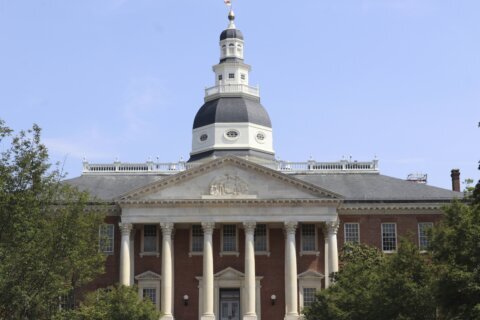This article was republished with permission from WTOP’s news partners at Maryland Matters. Sign up for Maryland Matters’ free email subscription today.
This content was republished with permission from WTOP’s news partners at Maryland Matters. Sign up for Maryland Matters’ free email subscription today.
Efforts to expand Maryland’s commuter rail service into a regional system took a step forward with the signing of an agreement with officials in Delaware and Virginia.
The framework agreement signed earlier this month opens the door to discussion that could lead to expanded service to Newark and northern Virginia.
“We must take a regional approach to create a fully connected transportation network, and these agreements will help us deliver seamless transit service across state lines,” Maryland Transportation Secretary Paul J. Wiedefeld said in a statement. “Maryland is working to create a transit network that expands opportunities and options for all customers. Collaboration with our partners in Virginia and Delaware is critical in that mission.”
The agreements are an initial step in ongoing discussions between Maryland and Delaware and Virginia. Seamless rail passage between the states is likely still years away.
“Maryland is committed to working with our neighbors to increase convenient and accessible transit across the entire region because we know an expanded transit network leads to expanded opportunities for everyone,” Gov. Wes Moore (D) said in a statement. “The partnerships outlined in these agreements will help us bring greater options to thousands of potential transit riders.”
All three states would need to finalize a plan that will also likely include agreements with Amtrak, CSX and others.
The envisioned system would more easily connect Maryland rail commuters in Cecil County to the Southeastern Pennsylvania Transportation Authority system. State transportation officials still need to evaluate operations and infrastructure needs in Maryland.
In January, the state signed an agreement to begin the replacement of the B&P Tunnel, now known as the Frederick Douglass Tunnel.
At the same time, Maryland transportation officials are studying potential expansion of MARC service from Martinsburg, West Virginia into Western Maryland. Potential stops include Hagerstown, Hancock and Cumberland.
That study is expected to be completed and sent to the General Assembly later this year.
To provide MARC “run-through service” into Virginia, the state must coordinate with the Virginia Passenger Rail Authority, Virginia Railway Express, and rail companies.
“This partnership on a framework agreement is an important first step forward for VPRA to further advance the Commonwealth’s goal of reducing congestion on our roads and highways by providing more reliable, consistent, and accessible passenger rail transportation options,” Virginia Passenger Rail Authority Executive Director DJ Stadtler said in a statement.
The potential future service depends on completion of the Long Bridge project, which includes a new rail bridge spanning the Potomac River from the District of Columbia to Virginia, and related track expansions in the District and in Northern Virginia.
The $2.3 billion expansion project adds a new two-track bridge parallel to the existing 117-year-old two-track bridge.
That project faces increased costs and remains in the preliminary engineering phase. Construction is not expected to start until next year.







